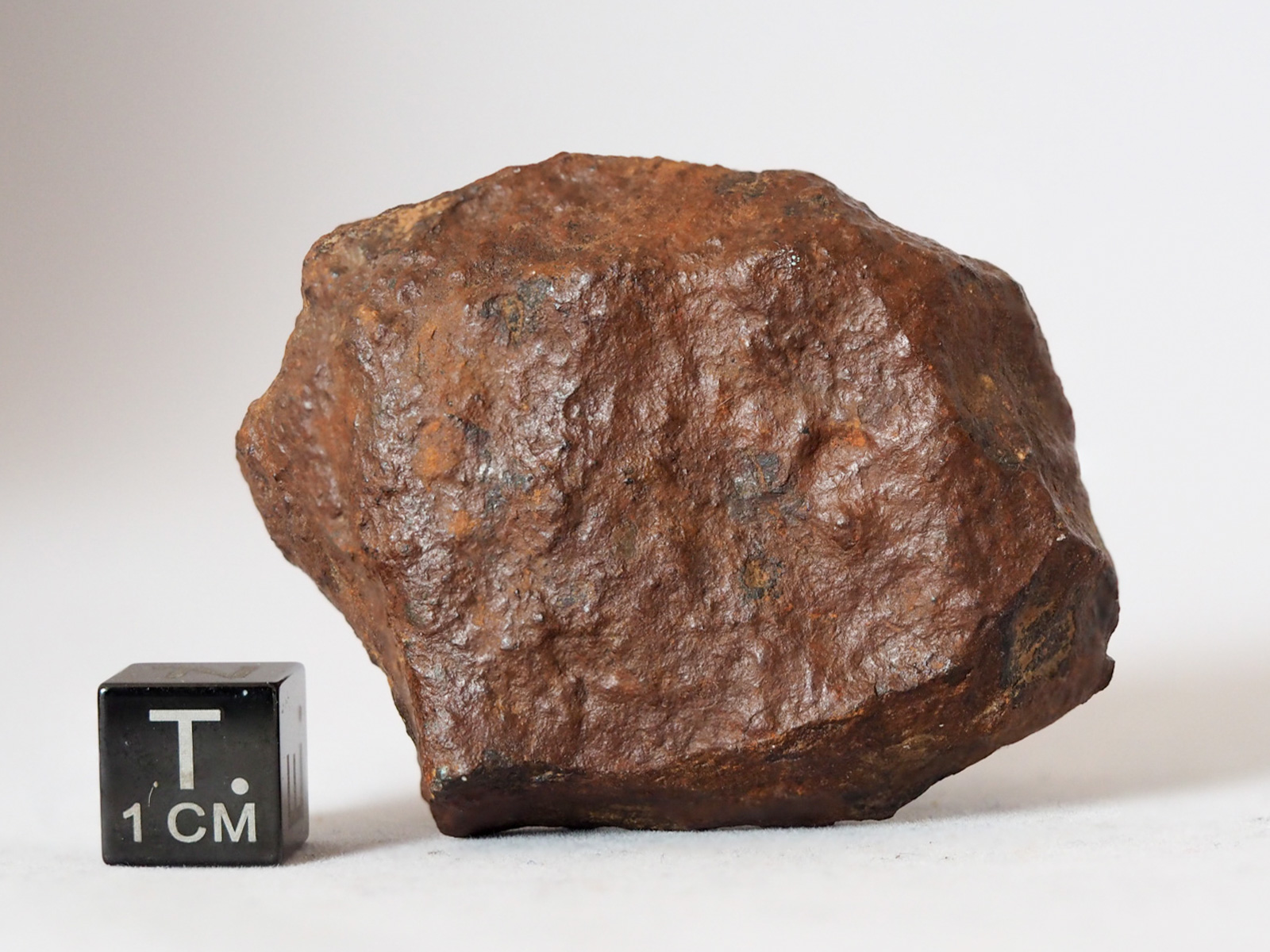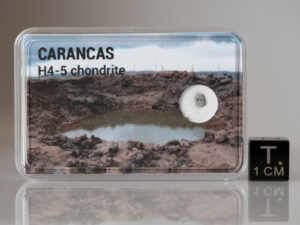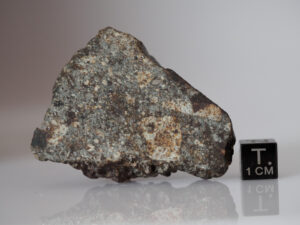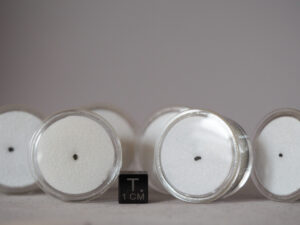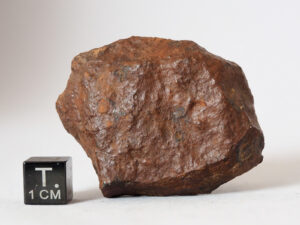Description
FALL OF THE TSAREV, USSR, STONY METEORITE
Name: TSAREV
Place of fall: Near Tsarev village, Volgograd district, USSR.
48°42’N., 45°42’E.
Date of fall: December 6, 1922, 0700 hrs (?), found 1968, recognized 1979.
Class and type: Stone. Olivine-hypersthene chondrite (L5).
Number of individual specimens: 28
Total weight: 1131.7 kg
Circumstances of find: Found in fields, the first few specimens were found by B.G. Nikiforov. The largest mass weighs 284 kg, the smallest 761 g. The greatest distance between the find sites was 6.0 km.
Source: R.L. Khotinok, Committee on Meteorites, Academy of Sciences, Moscow, USSR.
Meteoric Stone Rain Tsarev is the largest meteoric rain both in Russia and in the USSR, and the third in the world, yielding only Kiren’s stone meteor (China) and Allende (Mexico). These are 82 of the found chondritic meteorite, a total weight of approximately 1.5 tons, distributed on an area 25 square kilometers. Almost probably found far from all fragments of this fall. In early December 1922, a drop from the sky of the sky (meteorite) was observed in the north of the Astrakhan province. The rumor about it was partitioned throughout Russia, and the stone (meteorite) was attributed to unusually large sizes. Although various institutions The south of Russia and sent to the intended place to fall of their representatives, nevertheless finding this stone (meteorite) to anyone.
From the leaflet of the Academy of Sciences, 1923:
“Geological and Mineralogical Museum of the Academy of Sciences to promote searches found it possible to declare a prize for finding a meteorite on the following conditions: Geological and Mineralogical Museum Russian Academy Sciences pays modern currency hundred (100) rubles in gold at the existing course of the ruble (over two and a half billion on account of 1921) from the special fund released to him for the acquisition of meteorites … “.
The meteorite was found only in 1968. When uninstalling the fields of the statement “Leninsky”. The first discharge message was obtained after another 11 years (in 1979) from the electric welder B. G. Nikiforov.
Electrician named Boris Nikiforov from the village of Tsarev wrote a letter (1979) to the Committee on the Meteorites of the Academy of Sciences (An) of the USSR, in which he said that since the spring of 1968, in the fields of the Counsel, under field works, workers have repeatedly found large rusted stones. Tractor drivers on the field felt a characteristic impetus, bumping into one of these stones and even put them on a plow as an additional cargo.Nikiforov once worked with oil geologists and was interested in astronomy and meteorite, so the stones on the fields did not accidentally seemed suspicious. He never seen anything like that. Especially reluctant the large proportion of these stones. In his letter, Nikiforov informed the Committee that he seemed to discovered many major meteorites. In the Committee, he was not particularly believed. It seemed unlikely that the stones, such a long lacquered in a completely open bowls, so to speak on a universal ferris, may be meteorites. Nevertheless, the Committee sent a stereotypical response to Nikiforov, in which he asked him to split a small sample and send it to Moscow to analyze. To the greatest surprise of employees of the Committee, a 324-gram sample turned out to be a meteorite – chondrit type L5 and became new addition to the collection of meteorites of the Academy of Sciences.Employee of the Committee on Meteorites R. Khotyaki was immediately sent to Tsarev. When he entered through the gateway to Nikiforov, it was literally dumbfounded, seeing a whole bunch of rusty stones, each of which was more than half a meter in diameter. Nikiforov said that there are at least four stones in the fields even more, but they are too heavy and not to bring them on themselves. Each of the seven meteorites in the yard Nikiforova weighed a few tens of kilograms. Their surface as a result of long-term oxidation was covered with bright rust, but despite this, the glazed melting bark was well preserved with well-pronounced specific deepening, the so-called regimal magtelles, which is the result of a meteorite flight in an atmosphere with space speed.According to R. Khotynka – the author of the first scientific publicationdevoted to the meteorite prince in his internal structure It is clearly present traces of late changes – metamorphism. These changes appeared most likely as a result of a grand collision that the meteorite has undergone hundreds of millions of years ago during its wander in outer space.At that time, many meteorites remained directly at the place of their fall. The state farm was relatively young and workers were quite accurately knew how the fields were unpacked and where and what stones were found. The 4 largest meteorites remained on the spot, and Nikiforov was able to show exactly where he found 7 large stones dragging into his yard.
In October 1979, a twelfth meteorite was found with a mass of more than 50 kilograms, and in April and August 1980 – even thirteen. It remains only to be surprised as such a major drop, accompanied by the same seid of the weight of an eyewitness with a bright car and widely lit in the reports in the newspapers, waited for its final discovery so long. Since the trajectory and distances to the car were initially evaluated incorrectly, the search for “hot pursuit” was carried out simply not in that place. “Strange” stones began to be discovered only when the tractor of the Occake Tsarev began to raise the virgin. Found fragments allowed at least approximately evaluating the initial, duplicate mass of Tsareva. According to Valentina Tsvetkov – the main explorer of the place of fall, she could reach 10 tons. Direct chemical I. physical analysis Fragments of secured composition of stones and structure. Further field work carried out by the Meteorites Committee made it possible to determine the orientation, size and form of the area of u200bu200bfalling individual fragments of the meteorite – the so-called “ellipsoid of dispersion”, as well as to establish the nature of the mass distribution inside the ellipsoid. During the meteorite rain, the fragments of the cosmic body scattered in the atmosphere are sorted according to their mass. Lighter stones are faster in front of their flight through the atmosphere and thus falling earlier than larger debris. The study of the dispersion ellipsoid explicitly confirmed the evidence of eyewitnesses on the direction of the flight of a bar as a whole from the south to the north, since the largest fragments were found in the northern part of the fall area. According to the final estimate, the trajectory had an azimut of 140 degrees, which corresponds to the direction of flight from the south-east to the north-west. The composition of the Tsarev meteorite corresponds to the composition of typical chondrite type L5 – 40% SiO 2, 25% MGO, and 22.3% nickel gland. The density of the meteorite substance ranges from 3.3 to 3.5 g / cm 3. On the this moment The total mass of the collected fragments on the square is about 25 square meters. The CM was 1.5 tons. The weight of the largest fallen fragment was 284 kg.

